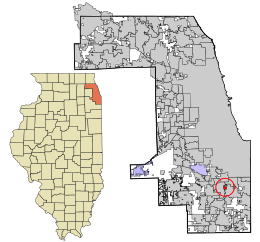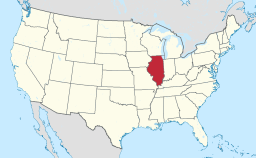Phoenix, Illinois
| Phoenix, Illinois | |
| Village | |
| Country | United States |
|---|---|
| State | Illinois |
| County | Cook |
| Township | Thornton |
| Coordinates | 41°36′44″N 87°37′50″W / 41.61222°N 87.63056°WCoordinates: 41°36′44″N 87°37′50″W / 41.61222°N 87.63056°W |
| Area | 0.45 sq mi (1 km2) |
| - land | 0.45 sq mi (1 km2) |
| - water | 0.00 sq mi (0 km2) |
| Population | 1,964 (2010) |
| Density | 4,364.4/sq mi (1,685/km2) |
| Mayor | Terry Wells |
| Timezone | CST (UTC-6) |
| - summer (DST) | CDT (UTC-5) |
| Postal code | 60426 |
| Area code | 708 |
|
Location in Cook County and the state of Illinois.
|
|
|
Location of Illinois in the United States
|
|
|
Website: www |
|
Phoenix is a village in Cook County, Illinois, United States. The population was 1,964 at the 2010 census. It is located approximately 19 miles (31 km) south of the Chicago Loop and is part of the Chicago–Naperville–Joliet, IL-IN-WI Metropolitan Statistical Area.
The development of Phoenix is closely tied to its larger neighbor, Harvey. Harvey was established as an industrial city with no saloons. Many of its early factories were located between the Illinois Central Railroad and Harvey's eastern boundary at Halsted Street. One local businessman, William McLatchy, owned a large tract of land in an unincorporated area outside of Harvey. Soon, five saloons had opened in the area and a small housing subdivision known as Phenix Park was constructed during the 1890s. City leaders in Harvey, seeing businesses just outside their boundaries selling alcohol to local workers, sought to annex Phenix Park and render it "dry" or free of alcohol-related establishments. The residents of Phenix Park wanted to retain local control of their affairs as an independent village. On August 29, 1900, an election was held to determine the future status of the area. A total of 56 votes were cast with 38 (67.9%) voting in favor of incorporation and 18 (32.1%) against. Despite legal challenges from Harvey, the result was upheld.
After incorporation, the name Phenix Park was changed to Phoenix. By 1910, the village had a population of 500, with most residents being of either Dutch or Polish ancestry. The first African Americans moved to Phoenix in 1915. Most came from Chicago and the South. Industry in Harvey and the railroads provided a strong employment base for Phoenix residents. The African American population steadily increased during the 1920s. By 1930, the village was home to 3,033 people. The demographic makeup of the community was 84.2% White, 15.1% Black, and 0.7% other. Growth continued through the 1940s and 1950s. New housing was constructed to accommodate this growth. The population in 1960 was 4,203. At this time, Phoenix had a diverse ethnic composition but the community was racially segregated. African Americans, comprising 65.3% of the population, lived in the northern portion of the village while Whites, forming 34.7% of the population, lived in the southern portion of Phoenix. In 1960, the municipal administration of Phoenix voted to de-annex the predominantly White portion of the village into Harvey. The exchange occurred in 1962 and with it, Phoenix lost one-third of its population as well as 60% of its tax base.
...
Wikipedia


